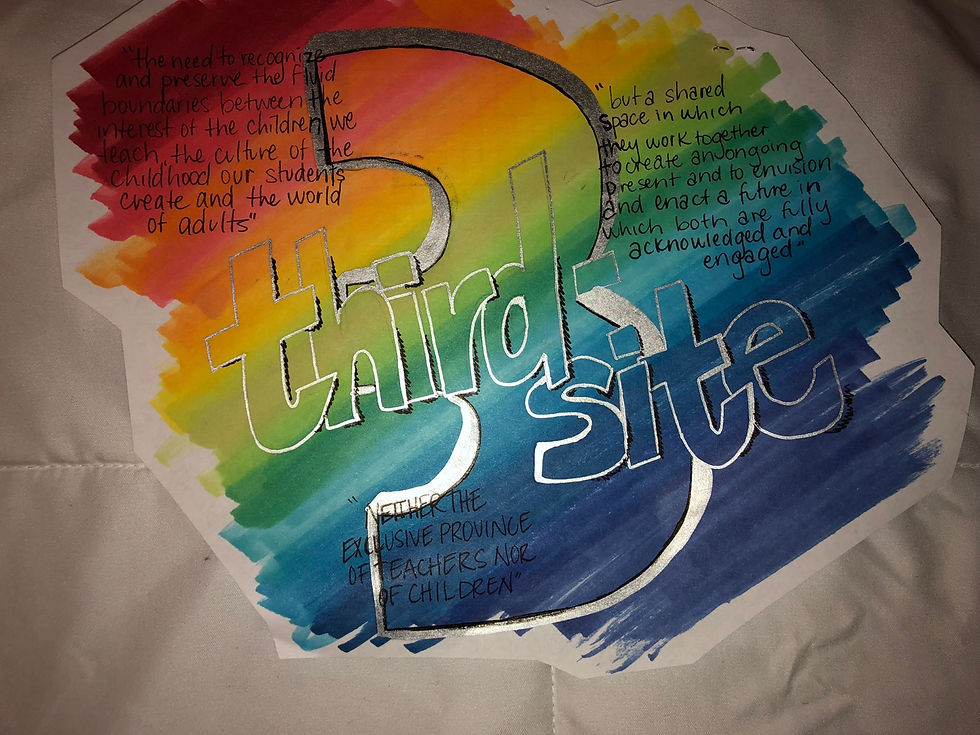Knowledge Garnered from Art Education Articles
- Morgan Boswell
- Nov 28, 2018
- 3 min read
Thought my elementary art education course we have been making visual responses that reflect aspects of art ed readings and course material that we find relevant, notable, and or interesting.
I have divided my map fragments into the categories: Critique of Contemporary Practices, Goals as a Teacher, and Contemporary Theories
Critique of Contemporary Practices

"The child is viewed as an individual whose artistic expression is a reflection of where the child is developmentally" (Gaudelius, 2002).
Squiggles were a part of the gifted curriculum at Fairmount Elementary. They were done during class as well as used in the test to gain admission into the gifted program and pass the creativity aspect of the the test. I sure didn't mind though. For me, squiggles were the best part of the day... FINALLY a pice of paper and materials I had the opportunity to be in control of.

"As long as the art program seems to be producing products that have a free and creative look school persons can say life in school is not just a cognitive matter" (Efland, 1976).
Without a designated art class in elementary school, I was left with my core teachers trying to incorporate art into the day as a sort of "cognitive down time." This resulted in a lot of seasonal crafts and coloring pages. To the school administrators this seemed to replace art perfectly fine. They did observations and saw us coloring and cutting, getting our "hands on" time, little did they know we were all working towards the pre-made class example.
Goals as a Teacher

I was really inspired by the Wexler article, though I have heard of Reggio Amelia programs before this article helped me to understand aspects that I before thought could only be applied as a whole. The parts about listening were especially telling, as I feel that it is a common part of American culture to assume what adults have to say is more important that what kids want to say.

This article blew me away, it was amazing to hear/read about a free draw that worked to produce such awesome experiences for the boys. My map fragment is a word blob featuring quotes about the students that really stood out to me. I hope to one day foster an environment that produces experiences like these.

"When teaching about social practice, I've found that children can understand it better when they jump into the social practice of artists we study" (Thulson, 2013).
This is article is definitely one that I am glad to have in my resource bank. It has so many relevant examples and ideas of how to incorporate contemporary art into the classroom with young students. I love the idea of having site specific installations and how in a way that can become a whole new medium.

"So why do we keep dumping truckloads of sand on our students blinding them, instead of lifting up the grain so they can learn to see for themselves? Why do we keep trying to cover the field when we can honor the discipline by teaching less of it?" (Palmer, 1998)
This reading really hit home to my own education, this quote in particular. It was very common in my high school for the teachers to try to cover every aspect of a topic that I sometimes felt similar to this drawing, buried in content. I like the that follows which states the underlying goals of the teacher was to honor the discipline because that is what I believe my teachers were trying to do even if it did not always feel that way.
Contemporary Theories

A big idea's based curriculum feels like it could easily be applied to the art classroom. I think focusing on big ideas is a great way for students to still study and learn about artists without creating mimicry work (Walker).

Exploring different strategies for contemporary art education

I think the concept behind the third pedagogical site is very interesting and inspirational. I also believe with little adjustments to the classroom and the teachers attitudes and actions progress toward creating a relationship like those fostered by the third site could begin to grow (Thompson, 2009).
References
Efland, A. (1976). The school art style: A functional analysis. Studies in Art Education, 17(2), 37-44.
Gaudelius, Y. & Speirs, P. (2002) Contemporary issues in art education. Upper Saddle River, NJ: Prentice Hall. (pp. 1-18.)
Grube, V. (2009). Admitting their worlds: Reflections of a teacher/researcher on the self-initiated art making of children. International Journal of Education and the Arts. 10(7), 1-15.
Palmer, P. (1998) The courage to teach (chapter 5)
Thompson, C.M. (2009). Mira! looking, listening, and lingering in research with children. Visual Arts Research.
Thulson, A. (2013). Contemporary practice in the elementary classroom: A study of change. Art Education, 17-23.
Walker, Teaching meaning in artmaking chapter 1: Big ideas and artmaking
Wexler, A. (2004). A theory for living: Walking with reggio emilia. Art Education






Comments